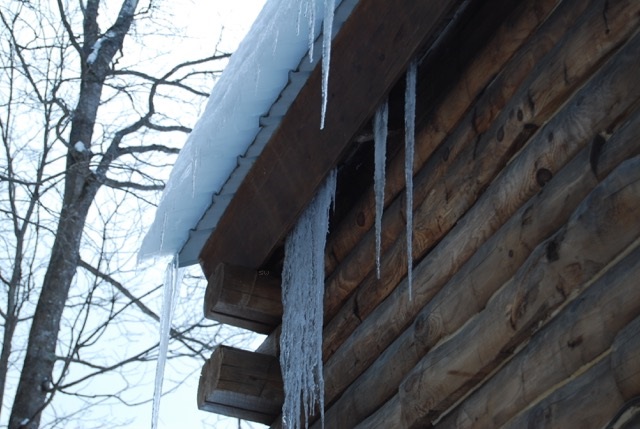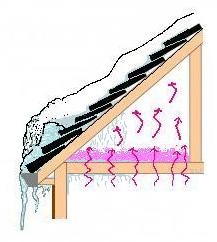Icicles on my roof - What causes them?

 Here we are on the doorstep of winter and one of the biggest questions we receive at AskARoofer.com has to do with Icicles and Ice Dams.
Here we are on the doorstep of winter and one of the biggest questions we receive at AskARoofer.com has to do with Icicles and Ice Dams.
These Ice dams can cause much damage to your home and must be taken care of. When you see icicles that form from your gutters and eaves this may be a warning sign of Ice Dams. This photo to the right was provided by ARC Roofing from Lewiston Maine and is a great example of this problem they get up in the North East of the United States.
There are two main reasons that ice dams occur:
Lack of proper amount of insulation in the attic.
It is a good idea to have your attic checked for a proper level of insulation. Different heights of insulation required may vary in different part of the country. Here the picture to the left shows a need for more insulation. The red arrow is pointing to the top of the 2″ x 4″ bottom chord of the truss which is only 3.5 inches tall. Where I am from R-38 or about 13-14 inches using blown-in insulation is the excepted level of insulation required. This reduces the heat, from the living space below, from rising and heating the roof sheathing, thus melting the snow on the roof. This melted snow flows downwards till it gets near the eave where it freezes and can form these icicles.
Poorly ventilated attic space
Another cause of ice dams can be poor attic ventilation can contribute to the problem. having good airflow from the outside mixing with the warmer air entering the attic help stop the melting of the snow that again causes icicles and ice dams. The National Roofing Contractors Association suggests 1 foot of ventilation for every 150 feet of living space. { Where vapor barrier is present 1 foot per 300 feet is acceptable. }
To have the best amount of insulation without choking off the intake vents, it is a good idea to use baffles as shown here to the right. Your roofing or insulating contractor knows how to best use these baffles and the amount needed. Having a balanced attic ventilation system in place helps reduce the chance of Ice Dams and Icicles forming in the cold a clement but also reduces the condensation that can form causing water seepage into the home. It acts as a roof leak but when there is no rain. When cold air meets warm air condensation happens. Just like a cold beer on a summer day and you get slapped when you set the cold mug on the wood coffee table. The movement of air in the attic helps stop condensation from occurring.
So there you are, a couple of things to look at if you see icicles forming on your roof's edge.
Have a question? AskARoofer.
Find your local roofing contractor in the RoofersCoffeeShop® Contractor Directory.







Comments
Leave a Reply
Have an account? Login to leave a comment!
Sign In